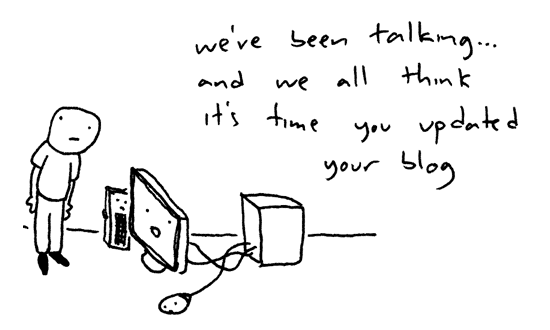It has been close to a year since Google introduced the rel=author
markup to the world, have you implemented it yet? For something so
simple it sure has the potential to be a game changer for your blogging
niche as well as your personal brand building online.

By connecting your Google+ profile with the content you create and publish you are essentially building your authority as a trusted voice. You are also adding credibility to those searching that you are a real person creating the content they crave and consume. While there may be some bloggers and companies that take the time to create sock puppet accounts most will not as it is time consuming and difficult for most to gain much of a return.
Let’s look at linking your blog to your Google Profile first. Linking these two allows Google to know that you are an author for this blog. This may be a link from an author page, about page, or it could be a link from your byline.
Your next move is to add a reciprocal link from your profile to the site you are updating. Inside your Google+ profile you will need to click on the about tab and scroll down to “Contribute to” section. You will add a custom link and in some cases it will be the URL of the author or about page rather than root.
Here is how you would do all of this in real life:
So this is how a Google+ profile URL might look like: https://plus.google.com/101570221368373054249/
You would then need to add rel=author to the end of it and have it look something like this: https://plus.google.com/101570221368373054249/?rel=author and link it to your bio or byline.
Then you would go into your Google+ profile and edit the “About” section. Go to “Contributor To” and add the site. If for instance it is a one-off post you would add the direct URL for that post, if it is a site you contribute on, you add a link to your author profile, and if it is a a site like ORM, I added a link to it on the “About Us” page.
For more details, visit Webmaster Tools and learn how to implement it.
You can test all your hard work with Google’s Rich Snippet Testing Tool.
Once you implement the rel=author markup, everyone will see your name and image to left of your own content. This is a huge advantage over the other search results that haven’t quite figured out how to add the rel=author markup.
If you engage in guest blogging, this markup could also increase your brand by connecting all your content to your profile. You can begin to have a singular voice and become more recognizable in your niche.
Photo credits: http://www.virtualsocialmedia.com/wp-content/uploads/2010/07/Online-Reputation-Management-Services.jpg, http://www.dentalheroes.com/wp-content/uploads//2009/12/online-reputation-management.jpg

By connecting your Google+ profile with the content you create and publish you are essentially building your authority as a trusted voice. You are also adding credibility to those searching that you are a real person creating the content they crave and consume. While there may be some bloggers and companies that take the time to create sock puppet accounts most will not as it is time consuming and difficult for most to gain much of a return.
Installing the rich snippet Rel=Author can help add to your blog’s credibility and visibility.
This markup language is also beneficial to your reputation management
strategy. By connecting the content to your Google+ profile it will
identify this information as being authentic and associate it to your
name and give you more real estate for searches involving your name.How to Set Up Rel=Author on Your Blog
To add the Rel=Author markup you will need to link to your Google Profile and your blog.Let’s look at linking your blog to your Google Profile first. Linking these two allows Google to know that you are an author for this blog. This may be a link from an author page, about page, or it could be a link from your byline.
Your next move is to add a reciprocal link from your profile to the site you are updating. Inside your Google+ profile you will need to click on the about tab and scroll down to “Contribute to” section. You will add a custom link and in some cases it will be the URL of the author or about page rather than root.
Here is how you would do all of this in real life:
So this is how a Google+ profile URL might look like: https://plus.google.com/101570221368373054249/
You would then need to add rel=author to the end of it and have it look something like this: https://plus.google.com/101570221368373054249/?rel=author and link it to your bio or byline.
Then you would go into your Google+ profile and edit the “About” section. Go to “Contributor To” and add the site. If for instance it is a one-off post you would add the direct URL for that post, if it is a site you contribute on, you add a link to your author profile, and if it is a a site like ORM, I added a link to it on the “About Us” page.
For more details, visit Webmaster Tools and learn how to implement it.
You can test all your hard work with Google’s Rich Snippet Testing Tool.
Increase Your Content’s Visibility
There was a time before rel=author that individuals logged in might be able to see something that might have been tweeted or shared by you but only if they were connected with you.Once you implement the rel=author markup, everyone will see your name and image to left of your own content. This is a huge advantage over the other search results that haven’t quite figured out how to add the rel=author markup.
Higher Click-Through Rates
Since the inception of rel=author, studies have shown that having your image next to the content actually increases the click-through rate of the given search result. Having a photo next to your listing gives the result authenticity and a greater chance that it will be clicked on.Personal Brand Building
Pick your image wisely as it should be an image associated with your blog. As the visitor clicks on your result and begins to navigate through your content they can associate your face and name to the content.If you engage in guest blogging, this markup could also increase your brand by connecting all your content to your profile. You can begin to have a singular voice and become more recognizable in your niche.
Future Search Benefits
By creating these power-user accounts it adds value to your blog and becomes a safe signal for Google. The increased belief that Google+ and author authenticity will play a significant role in future organic ranking should move you to make the necessary changes to your blog today.Photo credits: http://www.virtualsocialmedia.com/wp-content/uploads/2010/07/Online-Reputation-Management-Services.jpg, http://www.dentalheroes.com/wp-content/uploads//2009/12/online-reputation-management.jpg






